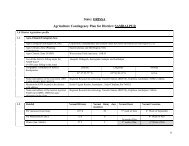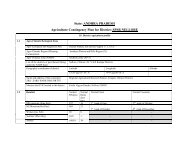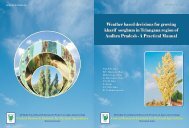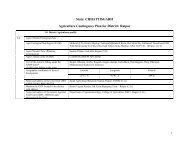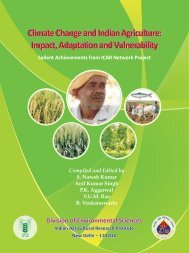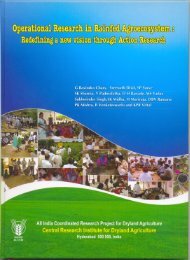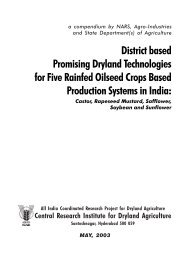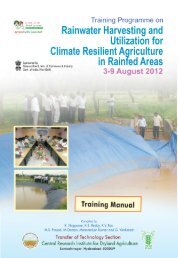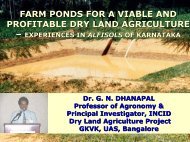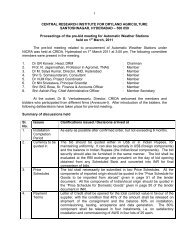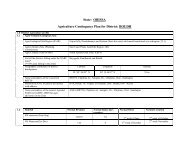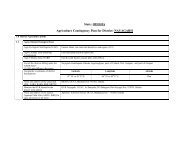State: TAMILNADU Agriculture Contingency Plan for District ... - CRIDA
State: TAMILNADU Agriculture Contingency Plan for District ... - CRIDA
State: TAMILNADU Agriculture Contingency Plan for District ... - CRIDA
Create successful ePaper yourself
Turn your PDF publications into a flip-book with our unique Google optimized e-Paper software.
1.1<br />
1.2<br />
Agro-Climatic/Ecological Zone<br />
Agro Ecological Region / Sub Region<br />
(ICAR)<br />
Agro-Climatic Region (<strong>Plan</strong>ning<br />
Commission)<br />
<strong>State</strong>: <strong>TAMILNADU</strong><br />
<strong>Agriculture</strong> <strong>Contingency</strong> <strong>Plan</strong> <strong>for</strong> <strong>District</strong>: NILGIRIS<br />
1.0 <strong>District</strong> <strong>Agriculture</strong> profile<br />
Western Ghats and Coastal Plain, hot humid-per humid eco-region (19.2.)<br />
Southern Plateau and Hills Region (X)<br />
Agro Climatic Zone (NARP) High altitude and hilly region (7.0)<br />
List all the districts or part thereof falling<br />
under the NARP Zone<br />
The Nilgiris, Kodaikanal, Shevroy, Elagiri, Javadhi, Kollimalai,<br />
Pachamalai, Yercaud, Anamalais, Palani and Podhigaimalai.<br />
Geographic coordinates of district Latitude Longitude Altitude<br />
Name and address of the concerned ZRS/<br />
ZARS/ RARS/ RRS/ RRTTS<br />
11 ° 10’ and 11 ° 45’<br />
TNAU Horticultural Research Station, Ooty-643001<br />
76 ° 14’ and 77 ° 2’ E<br />
Mention the KVK located in the district UPASI - KVK, Glenview, Coonoor - 643101, The Nilgiris Dt.<br />
Rainfall Average (mm) Normal Onset<br />
750 m<br />
Normal Cessation<br />
SW monsoon (June-Sep): 794 1 st Week of June 1 st week of October<br />
NE Monsoon(Oct-Dec): 361 2 nd week of October 4 th Week of December<br />
Winter (Jan- Feb) 56<br />
Summer (Mar-May) 230<br />
Annual 1441
1.3<br />
1. 4<br />
1.5<br />
Land use<br />
pattern of the<br />
district (latest<br />
statistics)<br />
Area (`000 ha)<br />
Geographical<br />
area<br />
Forest area Land under<br />
non-<br />
agricultural use<br />
Permanent<br />
pastures<br />
Cultivable<br />
wasteland<br />
Land under<br />
Misc. tree<br />
crops and<br />
groves<br />
Barren and<br />
uncultivable<br />
land<br />
Current<br />
fallows<br />
Other fallows<br />
254.5 142.6 10.0 5.1 2.0 3.8 3.4 8.2 1.9<br />
Major Soils Area (‘000 ha) Percent (%) of total<br />
Deep Red Soil 79.6 32.7<br />
Moderately Deep Black 71.5 29.3<br />
Moderately Shallow 8.6 3.5<br />
Shallow Black 9.2 3.7<br />
Shallow Red 21.1 8.7<br />
Very Deep Black 12.2 5.01<br />
Very Deep Red 32.0 13.1<br />
Agricultural land use Area (‘000 ha) Cropping intensity %<br />
Net sown area 79.2 100.0<br />
Area sown more than once -<br />
Gross cropped area 79.3<br />
2
1.6 Irrigation Area (‘000 ha)<br />
Net irrigated area 0.7<br />
Gross irrigated area 0.7<br />
Rainfed area 78.5<br />
Sources of Irrigation Number Area (‘000 ha) % area<br />
Canals 0.4 2.2<br />
Tanks - - -<br />
Open wells - - -<br />
Bore wells - 0.5 -<br />
Lift irrigation schemes - - -<br />
Other sources - 0.1 20.3<br />
Total - - -<br />
Pump sets - 1.1 100.0<br />
Micro-irrigation<br />
Groundwater availability and use<br />
Over exploited<br />
No. of blocks % area Quality of water<br />
Critical<br />
Semi- critical<br />
Good<br />
Safe 4 100<br />
Wastewater availability and use Data not available<br />
*over-exploited: groundwater utilization > 100%; critical: 90-100%; semi-critical: 70-90%; safe:
Area under major field crops & horticulture etc.<br />
1.7<br />
S.No.<br />
Major Field Crops cultivated<br />
Area (‘000 ha)<br />
Kharif Rabi Summer Total (ha)<br />
Irrigated Rainfed Irrigated Rainfed<br />
1 Paddy 0.8 -- 0.5 -- -- 1.3<br />
Horticulture crops - Fruits Total (ha)<br />
1 Carrot 2.3<br />
2 Potato 1.6<br />
3 Cabbage 0.6<br />
4 Beans 0.5<br />
5 Garlic -<br />
Other vegetables 0.5<br />
Medicinal and Aromatic crops Total (ha)<br />
1 Ginger 0.9<br />
2 Medicinal plants 0.7<br />
<strong>Plan</strong>tation crops<br />
1 Banana -<br />
2 Tea -<br />
3 Coffee -<br />
4 Pepper -<br />
5 Cut flowers -<br />
Fodder crops Total (ha)<br />
Total fodder crop area<br />
Grazing land 5.078<br />
Sericulture etc<br />
4
1.8<br />
Livestock Male (‘000) Female (‘000) Total (‘000)<br />
Non descriptive Cattle (local low yielding) 1.4 6.3 7.7<br />
Crossbred cattle 4.8 24.7 29.6<br />
Non descriptive Buffaloes (local low yielding)<br />
Graded Buffaloes<br />
0.2 0.9 1.1<br />
Goat - - 17.7<br />
Sheep - - 1.6<br />
Others (Camel, Pig, Yak etc.) - - 0.09<br />
Commercial dairy farms (Number) Above 50<br />
1.9 Poultry No. of farms Total No. of birds (‘000)<br />
1.10<br />
Commercial -- 74.9<br />
Backyard -- 45.0<br />
Fisheries (Data source: Chief <strong>Plan</strong>ning Officer)<br />
A. Capture<br />
i) Marine (Data Source: Fisheries<br />
Department)<br />
ii) Inland (Data Source: Fisheries<br />
Department)<br />
B. Culture<br />
i) Brackish water (Data Source: MPEDA/ Fisheries<br />
Department)<br />
ii) Fresh water (Data Source: Fisheries<br />
Department)<br />
No. of fishermen Boats Nets Storage facilities<br />
Mechanized Non- Mechanized Non-mechanized<br />
(Ice plants etc.)<br />
mechanized (Trawl nets, (Shore Seines,<br />
Gill nets) Stake & trap nets)<br />
No. Farmer owned ponds No. of Reservoirs No. of village tanks<br />
- - -<br />
Water Spread Area (ha)<br />
Yield (t/ha) Production (‘000 tons)<br />
5
1.11 Production and Productivity of major crops (Average of last 3 years: 2006, 07, 08)<br />
1.11 Name of crop Kharif<br />
Rabi Summer<br />
Total<br />
Production Productivity Production Productivity Production Productivity Production Productivity<br />
('000 t) (kg/ha) ('000 t) (kg/ha) ('000 t) (kg/ha) ('000 t) (kg/ha)<br />
1 Paddy 2.726 3370 1.579 3250 - - 4.305.83 3310<br />
2 Banana 23.961 36750 - - - - 23.961.00 36750<br />
Major Horticultural crops<br />
1 Potato 4.214 22540 16.487 22710 15.955 22410 36.658 22550<br />
2 Cabbage 7.320 67160 20.202 72410 15.971 73600 43.494 71060<br />
3 Carrot 16.927 26700 25.743 30180 27.212 30610 69.883 29160<br />
4 Beans 1.096 8630 2.106 9120 1.684 9360 4.887 9040<br />
5 Garlic 0.139 5560 0.117 5600 100 5560 0.356 5570<br />
6 Tea 592.477 9850 - - - - 592.477 9850<br />
7 Coffee 3.751 560 - - - - 3.751 560<br />
8 Pepper 0.403 190 - - - - 0.403 190<br />
9 Cut flowers 0.632 8750 - - - - 0.632 8750<br />
10 Medicinal plants 1.306 17300 - - - - 1.306 17300<br />
1.12 Sowing window <strong>for</strong> 5<br />
major crops (start and<br />
end of sowing period)<br />
Potato Cabbage Carrot Beans Beetroot<br />
Kharif- Rainfed July 1 st week to Aug 4 th<br />
July 1<br />
week<br />
st week to Aug 4 th<br />
July 1<br />
week<br />
st week to Aug 4 th<br />
July1<br />
week<br />
st week to Aug 4 th<br />
July1<br />
week<br />
st week to<br />
Aug 4 th week<br />
Kharif-Irrigated Jan 1 st week to Feb 4 th<br />
Jan 1<br />
week<br />
st week to –Feb 4 th<br />
Jan 1<br />
week<br />
st week to Feb 4 th<br />
Jan1<br />
week<br />
st week to Feb 4 th<br />
Jan1<br />
week<br />
st week to Feb<br />
4 th week<br />
Rabi- Rainfed March 1 st week to April March 1 st week to April 4 th March1 st week to April March 1 st week to April March1 st week to<br />
6
1.13<br />
Rabi-Irrigated<br />
What is the major contingency the district is prone<br />
to? (Tick mark and mention years if known during<br />
the last 10 year period)<br />
4 th week week 4 th week 4 th week April 4 th week<br />
- - - - -<br />
Regular Occasional None<br />
- - -<br />
Drought - - �<br />
Flood - �<br />
High intense storms - - �<br />
Cyclone - - �<br />
Hail storm - - �<br />
Heat wave - - �<br />
Cold wave �<br />
- -<br />
Frost � - -<br />
Sea water inundation �<br />
Pests and diseases<br />
Powdery mildew, Downey mildew, Root grubs,<br />
Nematode infestation, Blister blight (Tea)<br />
�<br />
- -<br />
-<br />
7
1.14 Include Digital maps of the district <strong>for</strong> Location map of district within <strong>State</strong> as Annexure I Enclosed: Yes<br />
Mean annual rainfall as Annexure 2 Enclosed: Yes<br />
Soil map as Annexure 3 Enclosed: Yes<br />
Annexure 1. Location map of The Nilgiris district and the blocks<br />
8
Rainfall (mm)<br />
300<br />
250<br />
200<br />
150<br />
100<br />
50<br />
0<br />
21<br />
Annexure 2. Mean annual rainfall of Nilgiris district<br />
of Tamil Nadu<br />
10<br />
25<br />
76<br />
154<br />
191<br />
Jan. Feb. March April May June July Aug. Sept. Oct. Nov. Dec.<br />
267<br />
188<br />
148<br />
187<br />
126<br />
48<br />
9
Annexure 3. Soil map of The Nilgiris district of Tamil Nadu<br />
10
2.0 Strategies <strong>for</strong> weather related contingencies<br />
2.1 Drought<br />
2.1.1 Rainfed situation (<strong>for</strong> both seasons of South west monsoon and north east monsoon)<br />
Condition Suggested <strong>Contingency</strong> measures<br />
Early season<br />
drought (delayed<br />
onset)<br />
Delay by 2 weeks<br />
(June 3 rd week)<br />
Major Farming<br />
situation<br />
Shallow red<br />
soils<br />
Crop/cropping system Change in crop/cropping<br />
system<br />
Potato – Carrot – Potato<br />
Varieties:<br />
Potato – Kufri jyoti<br />
Kufri Giridhari<br />
Kufri Giriraj (late<br />
blight resistant)<br />
Kufri Swarna<br />
Carrot – New koroda<br />
Super koroda<br />
King koroda<br />
Yearly nants<br />
Ooty -1<br />
F1 hybrid – Bijjo<br />
Class 1<br />
Agronomic measures Remarks on<br />
Implementation<br />
-<br />
-<br />
11
Condition Suggested <strong>Contingency</strong> measures<br />
Early season<br />
drought (delayed<br />
onset)<br />
Delay by 4 weeks<br />
(July 1st week )<br />
Major Farming<br />
situation<br />
Crop/cropping system Change in crop/cropping<br />
system<br />
Shallow red soils Potato – Carrot – Potato<br />
Beetroot / Radish / Cauliflower –<br />
Carrot – Potato<br />
Varieties :<br />
Beetroot: Ooty - 1. Crimson<br />
globe and redball<br />
Radish: Japanese long, Pusa<br />
rashmi and Arka nishant<br />
Cauliflower: Ooty 1, Swarna,<br />
Sandoz Hybrid. Pusadapoli and<br />
Snowmistique<br />
Cabbage – Potato - Carrot Beetroot / Radish / Caluliflower<br />
– Carrot – Potato<br />
Varieties :<br />
Beetroot: Ooty - 1. Crimson<br />
globe and redball<br />
Radish: Japanese long, Pusa<br />
rashmi and Arka nishant<br />
Cauliflower: Ooty 1, Swarna,<br />
Sandoz Hybrid. Pusadapoli and<br />
Snowmistique<br />
Agronomic measures Remarks on<br />
Implementation<br />
12
Condition Suggested <strong>Contingency</strong> measures<br />
Early season<br />
drought (delayed<br />
onset)<br />
Delay by 6<br />
Weeks (July 3 rd<br />
week )<br />
Major Farming<br />
situation<br />
Crop/cropping system Change in crop/cropping<br />
system<br />
Shallow red soil Potato – Carrot – Potato<br />
Cabbage – Carrot - Potato<br />
Greens – Carrot – Potato<br />
Greens: Chakravarthi keerai<br />
Ooty - 1.<br />
Amranthus : Ooty - 1<br />
Greens – Carrot – Potato<br />
Greens: Chakravarthi keerai<br />
Ooty - 1.<br />
Amranthus : Ooty - 1<br />
Agronomic measures Remarks on<br />
Implementation<br />
Condition Suggested <strong>Contingency</strong> measures<br />
Early season<br />
drought (delayed<br />
onset)<br />
Delay by 8<br />
weeks (August 1 st<br />
week)<br />
Major Farming<br />
situation<br />
Crop/cropping system Change in crop/cropping<br />
system<br />
Shallow red soil Potato – Carrot – Potato<br />
Green manure –Carrot – Potato<br />
Green manure: Lupin<br />
Buckwheat<br />
Cabbage – Carrot – Potatot Green manure –Carrot – Potato<br />
Green manure: Lupin<br />
Buckwheat<br />
Varieties :<br />
Buck wheat – Ooty local<br />
Lupin – Ooty local<br />
Agronomic measures Remarks on<br />
Implementation<br />
- -<br />
13
Condition Suggested <strong>Contingency</strong> measures<br />
Major Farming Crop/cropping system Crop management Soil management Remarks on<br />
Early season drought situation<br />
Implementation<br />
(Normal onset, Shallow red soil Potato – Carrot – Potato Thinning<br />
Earthing up<br />
Plastic sheet <strong>for</strong> mulching<br />
followed by 15-20<br />
may be supplied with<br />
days dry spell after<br />
sowing leading to<br />
poor germination/crop<br />
Cabbage – Carrot –<br />
Potato<br />
Life saving irrigation<br />
Anti transparent spray with<br />
Mulching with pine leaves<br />
Mulching with plastic sheets<br />
subsidy.<br />
Plastic sheets <strong>for</strong> pond<br />
stand etc.)<br />
kaoline<br />
lining may be supplied<br />
Rain water harvesting by<br />
pond lining<br />
with subsidy.<br />
Condition Suggested <strong>Contingency</strong> measures<br />
Mid season drought Major Farming Crop/cropping system Crop management Soil management Remarks on<br />
(long dry spell) situation<br />
Implementation<br />
At vegetative stage Shallow red soil Potato – Carrot – Potato Thinning of crop<br />
Earthing up<br />
Plastic sheet <strong>for</strong><br />
mulching may be<br />
Life saving irrigation<br />
Mulching with pine leaves supplied with subsidy.<br />
Cabbage – Carrot –<br />
Potato<br />
Anti transparent spray with<br />
kaoline<br />
Mulching with plastic<br />
sheets<br />
Rain water harvesting by<br />
pond lining<br />
Plastic sheets <strong>for</strong> pond<br />
lining may be supplied<br />
with subsidy.<br />
14
Condition Suggested <strong>Contingency</strong> measures<br />
Mid season drought Major Farming Crop/cropping system Crop management Soil management Remarks on Implementation<br />
(long dry spell) situation<br />
At reproductive stage Shallow red soil Potato – Carrot – Potato Thinning<br />
Earthing up<br />
Subsidy may be granted <strong>for</strong><br />
<strong>for</strong>ming rain water harvesting<br />
Life saving irrigation Mulching with pine leaves ponds.<br />
Shallow red soil Cabbage – Carrot – Potato Thinning<br />
Anti transparent spray<br />
with kaoline<br />
Life saving irrigation<br />
Incase of severe drought,<br />
Potato and carrot may be<br />
harvested in earlier date.<br />
The produce can be sold<br />
as table vegetables.<br />
Mulching with plastic<br />
sheets<br />
Rain water harvesting by<br />
pond lining<br />
Earthing up<br />
Mulching with pine leaves<br />
Mulching with plastic<br />
sheets<br />
Rain water harvesting by<br />
pond lining<br />
Condition Suggested <strong>Contingency</strong> measures<br />
Terminal drought Major Farming<br />
situation<br />
Plastic sheet <strong>for</strong> mulching may<br />
be supplied with subsidy.<br />
Plastic sheets <strong>for</strong> pond lining<br />
may be supplied with subsidy.<br />
Crop/cropping system Crop management Rabi Crop planning Remarks on<br />
Implementation<br />
Shallow red soil Cabbage – Carrot – Potato<br />
Potato – Carrot – Potato<br />
Life saving irrigation<br />
Incase of severe drought, Potato<br />
and carrot may be harvested in<br />
earlier date. The produce can be<br />
sold as table vegetables.<br />
Harvest at physiological maturity<br />
stage<br />
-- --<br />
15
2.1.2 Irrigated situation<br />
Condition Suggested <strong>Contingency</strong> measures<br />
Major Farming Crop/cropping system Change in crop/cropping Agronomic Remarks on<br />
situation<br />
system<br />
measures Implementation<br />
Delayed/ limited release of water<br />
in canals due to low rainfall<br />
Not applicable<br />
Condition Suggested <strong>Contingency</strong> measures<br />
Major Farming Crop/cropping system Change in crop/cropping Agronomic Remarks on<br />
situation<br />
system<br />
measures Implementation<br />
Non release of water in canals<br />
under delayed onset of monsoon in<br />
catchment<br />
Not applicable.<br />
Condition Suggested <strong>Contingency</strong> measures<br />
Major Farming Crop/cropping system Change in crop/cropping Agronomic Remarks on<br />
situation<br />
system<br />
measures Implementation<br />
Lack of inflows into tanks due to<br />
insufficient /delayed onset of<br />
monsoon<br />
Not applicable.<br />
Condition Suggested <strong>Contingency</strong> measures<br />
Major Farming situation Crop/cropping system Change in crop/cropping<br />
system<br />
Agronomic<br />
measures<br />
Remarks on<br />
Implementation<br />
16
Condition Suggested <strong>Contingency</strong> measures<br />
Major Farming situation Crop/cropping system Change in crop/cropping Agronomic Remarks on<br />
system<br />
measures Implementation<br />
Insufficient groundwater Tube well red soil Paddy Maize and vegetables 1.Limited -<br />
recharge due to low rainfall<br />
(Potato, Carrot, Beetroot, irrigation by<br />
Radish, Beans)<br />
alternate crops.<br />
Any other condition<br />
(specify)<br />
2. Alternate<br />
Furrow irrigation<br />
- - -<br />
3. Drip irrigation<br />
- -<br />
2.2 Unusual rains (untimely, unseasonal etc) (<strong>for</strong> both rainfed and irrigated situations)<br />
Condition Suggested contingency measure<br />
Continuous high<br />
rainfall in a short<br />
span leading to<br />
water logging<br />
Horticulture<br />
Potato<br />
Vegetative stage Flowering stage Crop maturity stage Post harvest<br />
Form trenches to drain excess<br />
water<br />
Form trenches to<br />
drain excess water<br />
Form trenches to drain excess water.<br />
Harvest and shift the crop to a safer place.<br />
Cabbage<br />
Form trenches to drain excess - Form trenches to drain excess water.<br />
-<br />
water.<br />
spray with 0.1% carbendazim to prevent disease<br />
Carrot<br />
spray with 0.1% carbendazim<br />
to prevent disease onset<br />
- onset.<br />
Incase of severe rain, harvest and market the<br />
product.<br />
-<br />
Beans - Form trenches to drain excess water.<br />
-<br />
Radish - spray with 0.1% carbendazim to prevent disease<br />
onset.<br />
-<br />
0.1% spray with carbendazim on<br />
the stored produce to prevent<br />
decaying / spoilage.<br />
17
Incase of severe, continuous rain, harvest and<br />
market the product.<br />
Garlic - Form trenches to drain excess water.<br />
spray with 0.1% carbendazim to prevent disease<br />
onset.<br />
Heavy rainfall with high speed winds in a short<br />
span<br />
Potato / Cabbage /<br />
Carrot / Garlic /<br />
Beans<br />
Horticulture<br />
Potato / Cabbage /<br />
Carrot / Garlic /<br />
Beans/ Tea / Cofee<br />
Form trenches to drain excess<br />
water.<br />
spray with 0.1% carbendazim<br />
to prevent disease onset<br />
Outbreak of pests and diseases due to unseasonal<br />
rains<br />
Horticulture<br />
Potato / Cabbage /<br />
Carrot / Garlic /<br />
Beans / Cofee / Tea<br />
Need based plant protection<br />
IPDM <strong>for</strong> pluses<br />
- Form trenches to drain excess water.<br />
spray with 0.1% carbendazim to prevent disease<br />
onset<br />
Form trenches to drain excess<br />
water.<br />
spray with 0.1% carbendazim to<br />
prevent disease onset.<br />
Form trenches to drain excess<br />
water.<br />
spray with 0.1% carbendazim to<br />
prevent disease onset<br />
- Need based plant protection IPDM <strong>for</strong> pluses Safe storage against storage pest<br />
and diseases<br />
18
2.3 Floods<br />
Condition Suggested contingency measure<br />
Transient water logging/ partial<br />
inundation<br />
Seedling / nursery stage Vegetative stage Reproductive stage At harvest<br />
Paddy Drain excess water Drain excess water Drain water excess water Drain water completely by<br />
<strong>for</strong>ming vertical and radial<br />
drains<br />
Banana Drain excess water Drain excess water Drain excess water<br />
Drain water completely by<br />
<strong>for</strong>ming vertical and radial<br />
Support trees with plastic<br />
ropes / Poles<br />
drains<br />
Support trees with plastic<br />
ropes / Poles<br />
Potato / Cabbage / Carrot / Garlic /<br />
Drain water completely by<br />
Beans / Garli / Cofee / Tea<br />
Drain excess water Drain excess water Drain excess water<br />
<strong>for</strong>ming vertical and radial<br />
drains<br />
Continuous submergence<br />
<strong>for</strong> more than 2 days<br />
Paddy Drain excess water<br />
If damage is more, raise new<br />
nursery<br />
Banana Drain excess water<br />
Horticulture<br />
Potato / Cabbage / Carrot / Garlic /<br />
Beans / Garlic<br />
If damage is more, plant new<br />
suckers<br />
Drain excess water<br />
If damage is more, raise new<br />
crop<br />
spray with 0.1% carbendazim<br />
to prevent disease onset<br />
Drain excess water<br />
Foliar spray with 1% urea /<br />
DAP<br />
Drain excess water<br />
Foliar spray with 1% urea /<br />
DAP<br />
Drain excess water<br />
Foliar spray with 1% urea /<br />
DAP<br />
spray with 0.1% carbendazim to<br />
prevent disease onset<br />
Drain water completely by<br />
<strong>for</strong>ming vertical and radial<br />
drains<br />
Drain water completely by<br />
<strong>for</strong>ming vertical and radial<br />
drains<br />
- -<br />
Drain water completely<br />
by <strong>for</strong>ming vertical and<br />
radial drains<br />
spray with 0.1%<br />
carbendazim to prevent<br />
disease onset<br />
Drain water completely by<br />
<strong>for</strong>ming vertical and radial<br />
drains<br />
19
Tea / Coffee<br />
Drain excess water<br />
-<br />
Foliar spray with 1% urea /<br />
DAP - -<br />
Sea water inundation Not applicable - - -<br />
2.4 Extreme events: Heat wave / Cold wave/Frost/ Hailstorm /Cyclone<br />
Extreme event type Suggested contingency measure<br />
Heat Wave<br />
Cold wave<br />
Paddy / Banana spray with 0.1% carbendazim<br />
to prevent disease onset<br />
Horticulture<br />
Potato / Cabbage / Carrot /<br />
Garlic / Beans / Garlic<br />
Frost<br />
Seedling / nursery stage Vegetative stage Reproductive stage At harvest<br />
Not applicable Not applicable Not applicable Not applicable<br />
Cover with pine leaves / tree<br />
leaves<br />
Cover with plastic sheets<br />
spray with 0.1% carbendazim<br />
to prevent disease onset<br />
Paddy / Banana spray with 0.1% carbendazim<br />
to prevent disease onset<br />
Horticulture<br />
spray with 0.1% carbendazim to<br />
prevent disease onset<br />
Cover with pine leaves / tree<br />
leaves<br />
Cover with plastic sheets<br />
spray with 0.1% carbendazim<br />
to prevent disease onset<br />
spray with 0.1% carbendazim to<br />
prevent disease onset<br />
- -<br />
Cover with pine leaves / tree leaves<br />
Cover with plastic sheets<br />
spray with 0.1% carbendazim<br />
to prevent disease onset<br />
- -<br />
-<br />
20
Potato / Cabbage / Carrot /<br />
Garlic / Beans / Cauliflower<br />
Hailstorm<br />
Cyclone<br />
Paddy / Banana<br />
Horticulture<br />
Potato / Cabbage / Carrot /<br />
Garlic / Beans / Cauli flower<br />
Cover with pine leaves / tree<br />
leaves<br />
Cover with plastic sheets<br />
spray with 0.1% carbendazim<br />
to prevent disease onset<br />
Cover with pine leaves / tree<br />
leaves<br />
Cover with plastic sheets<br />
spray with 0.1% carbendazim<br />
to prevent disease onset<br />
Cover with pine leaves / tree leaves<br />
Cover with plastic sheets<br />
spray with 0.1% carbendazim<br />
to prevent disease onset<br />
Not applicable Not applicable Not applicable Not applicable<br />
If damage is high, raise<br />
New nursery / Seedling<br />
If damage is high, raise<br />
New nursery / Seedling<br />
If damage is high,<br />
Go <strong>for</strong> short duration crop like<br />
Potato / Cabbage / Carrot /<br />
Garlic / Beans / Cauli flower<br />
If damage is high, raise<br />
New short duration crops like<br />
carrot / radish / amaranths<br />
If damage is high,<br />
Go <strong>for</strong> short duration crop like Potato<br />
/ Cabbage / Carrot / Garlic / Beans /<br />
Cauli flower<br />
If damage is high, raise<br />
New short duration crops like carrot /<br />
radish / amaranths<br />
-<br />
-<br />
-<br />
21
2.5 Contingent strategies <strong>for</strong> Livestock, Poultry & Fisheries:<br />
2.5.1 Livestock<br />
Drought<br />
Feed and<br />
Fodder<br />
availability<br />
Cyclone NA<br />
Suggested contingency measures<br />
Be<strong>for</strong>e the event During the event After the event<br />
As the district is sporadically affected with<br />
draught, the under mentioned measures should be<br />
taken to overcome fodder shortage problem<br />
Sowing of sorghum, maize, oats, Lucerne,<br />
Horsegram, Cowpea etc., during North-East<br />
monsoon under Rainfed <strong>for</strong> fodder production<br />
Fodder production with Sorghum – stylo-<br />
Sorghum on rotation basis.<br />
Create awareness on establishment of pasture with<br />
kikyu grass, rye, Phalaris aquatica, stylo, berseem,<br />
desmanthus, kolukkattai grass etc<br />
Creation of tree fodder models with Subabul,<br />
Glyricidia, Agathi, etc <strong>for</strong> tree fodder production<br />
during summer.<br />
Encouraging farmers to cultivate short-term fodder<br />
crops like sunhemp.<br />
Chopping of fodder should be made as mandatory<br />
in every village through supply and establishment<br />
of good quality crop cutters.<br />
Capacity building and preparedness of the<br />
stakeholders and official staff <strong>for</strong> the unexpected<br />
events<br />
Transport dry fodder bales from the fodder grid at<br />
DLF, Hosur to the drought affected villages<br />
Harvest the failed vegetable crops like Carrot and<br />
potato and supplement to the high productive<br />
livestock<br />
Harvest all the top fodder available (Subabul,<br />
Glyricidia, Agathi, Prosopis etc) and feed the LS<br />
during drought<br />
All the hay should be enriched with 2% Urea<br />
molasses solution or 1% common salt solution<br />
and fed to LS<br />
Encourage mixing available kitchen waste with<br />
dry fodder while feeding to the milch animals<br />
Use of unconventional and locally available cheap<br />
feed ingredients <strong>for</strong> feeding of livestock.<br />
Promotion of cultivation of Horse gram as<br />
contingent crop and harvesting it at vegetative<br />
stage as fodder<br />
Flushing the stock to recoup<br />
Replenish the feed and fodder banks<br />
Supply of quality seeds of COFS 29,<br />
Stylo and fodder slips of Co3, Co4,<br />
guinea grass well be<strong>for</strong>e monsoon to the<br />
farmers and encourage to grow by input<br />
subsidy<br />
22
Floods In case of early <strong>for</strong>ewarning (EFW), harvest<br />
all the crops that can be useful as fodder in<br />
future (store properly)<br />
Don’t allow the animals <strong>for</strong> grazing if<br />
severe floods are <strong>for</strong>ewarned<br />
Keep stock of bleaching powder and lime<br />
Carry out Butax spray <strong>for</strong> control of<br />
external parasites<br />
Identify the Clinical staff and trained<br />
paravets and indent <strong>for</strong> their services as per<br />
schedules<br />
Identify the volunteers who can serve in<br />
need of emergency<br />
Arrangement <strong>for</strong> transportation of animals<br />
from low lying area to safer places and also<br />
<strong>for</strong> rescue animal health workers to get<br />
involve in rescue operations<br />
Cold wave Cold wave: Covering all the wire meshed<br />
walls / open area with gunny bags/<br />
polyethylene sheets (with a mechanism <strong>for</strong><br />
lifting during the day time and putting<br />
down during night time)<br />
Heat wave NA<br />
Health and<br />
Disease<br />
management<br />
Procure and stock emergency medicines<br />
and vaccines <strong>for</strong> important endemic<br />
diseases of the area<br />
All the stock must be immunized <strong>for</strong><br />
endemic diseases of the area<br />
Precaution notice and vaccination during<br />
April:<br />
July:<br />
1. Foot and Mouth Disease –<br />
Udagamandalam Block.<br />
Precaution notice and vaccination during<br />
June:<br />
Transportation of animals to elevated areas<br />
Proper hygiene and sanitation of the animal shed<br />
In severe storms, un-tether or let loose the animals<br />
Avoid soaked and mould infected feeds / fodders to<br />
livestock<br />
Emergency outlet establishment <strong>for</strong> required medicines<br />
or feed in each village<br />
Spraying of fly repellants in animal sheds<br />
Allow <strong>for</strong> grazing between 10AM to 3PM during cold<br />
waves<br />
Add 25-50 ml of edible oil in concentrates and fed to the<br />
animal during cold waves<br />
Apply / sprinkle lime powder in the animal shed during<br />
cold waves to neutralize ammonia accumulation<br />
Carryout deworming to all animals entering into relief<br />
camps<br />
Identification and quarantine of sick animals<br />
Constitution of Rapid Action Veterinary Force<br />
Per<strong>for</strong>ming ring vaccination (8 km radius) in case of any<br />
outbreak<br />
Restricting movement of livestock in case of any<br />
epidemic<br />
Rescue of sick and injured animals and their treatment<br />
Organize with community, daily lifting of dung from<br />
relief camps<br />
Repair of animal shed<br />
Bring back the animals to the shed<br />
Cleaning and disinfection of the shed<br />
Bleach (0.1%) drinking water / water<br />
sources<br />
Deworming with broad spectrum<br />
dewormers<br />
Proper disposable of the dead animals /<br />
carcasses by burning / deep burying (4-8<br />
feet) with lime powder (1kg <strong>for</strong> small<br />
ruminants and 5kg <strong>for</strong> large ruminants) in<br />
pit<br />
Drying the harvested crop material and<br />
proper storage <strong>for</strong> use as fodder.<br />
Feed the animals as per routine schedule<br />
Allow the animals <strong>for</strong> grazing (normal<br />
timings)<br />
Keep close surveillance on disease<br />
outbreak.<br />
Undertake the vaccination depending on<br />
need<br />
Keep the animal houses clean and spray<br />
disinfectants<br />
23
September:<br />
1. Black Quarter – Gudalur Block.<br />
Precaution notice and vaccination during<br />
September<br />
December:<br />
1. Anthrax – Gudalur Block.<br />
Surveillance and disease monitoring<br />
network to be established at Joint Director<br />
(Animal Husbandry) office in the district<br />
Adequate refreshment training on draught<br />
/flood/cyclone management to be given to<br />
VAS, Jr.VAS, LI with regard to health &<br />
management measures.<br />
Procure and stock multivitamins & area<br />
specific mineral mixture<br />
Insurance Encouraging insurance of livestock Listing out the details of the dead animals Submission <strong>for</strong> insurance claim and<br />
availing insurance benefit<br />
Drinking<br />
water<br />
Identification of water resources<br />
Desilting of ponds<br />
Rain water harvesting and create water<br />
bodies/watering points (when water is<br />
scarce use only as drinking water <strong>for</strong><br />
animals)<br />
Construction of drinking water tanks in<br />
herding places/village junctions/relief camp<br />
locations<br />
Community drinking water trough can be<br />
arranged in shandies /community grazing<br />
areas<br />
Restrict wallowing of animals in water bodies/resources<br />
Purchase of new productive animals<br />
Bleach (0.1%) drinking water / water<br />
sources<br />
Provide clean drinking water<br />
24
Vaccination schedule in small ruminants (Sheep & Goat)<br />
Disease Season<br />
Foot and mouth disease (FMD) Preferably in winter / autumn<br />
PPR All seasons, preferably in June-July<br />
Black quarter (BQ) May / June<br />
Enterotoxaemia (ET) May<br />
Haemorrhagic septicaemia (HS) March / June<br />
Sheep pox (SP) December / march<br />
Vaccination programme <strong>for</strong> cattle and buffalo:<br />
Disease Age and season at vaccination<br />
Anthrax In endemic areas only, Feb to May<br />
HS May to June<br />
BQ May to June<br />
FMD November to December<br />
2.5.2 Poultry<br />
Drought Be<strong>for</strong>e the event<br />
Suggested contingency measures<br />
During the event After the event<br />
Shortage of feed ingredients Storing of house hold grain like maize, broken rice, Supplementation only <strong>for</strong> productive Supplementation to all<br />
bajra etc,<br />
birds with house hold grain<br />
Culling of weak birds<br />
Supplementation of shell grit (calcium)<br />
<strong>for</strong> laying birds<br />
Drinking water Rain water harvesting Sanitation of drinking water Give sufficient water as<br />
per the bird’s<br />
Health and disease management Culling of sick birds.<br />
Mixing of Vit. A,D,E, K and B-complex<br />
requirement<br />
Hygienic and sanitation<br />
Deworming and vaccination against RD and IBD including vit C in drinking water of poultry house<br />
Disposal of dead birds<br />
by burning / burying<br />
with line powder in pit<br />
25
Floods<br />
Shortage of feed ingredients<br />
Drinking water<br />
Health and disease management<br />
Cold wave<br />
Shelter/environment management<br />
Health and disease management<br />
Cyclone NA<br />
Heat wave NA<br />
In case of EFW, shift the birds to safer place<br />
Storing of house hold grain like maize, broken rice,<br />
bajra etc,<br />
Culling of weak birds<br />
Provide clean drinking water<br />
In case of EFW, add antibiotic powder in drinking<br />
water to prevent any disease outbreak<br />
Provision of proper shelter<br />
Arrangement <strong>for</strong> brooding<br />
Assure supply of continuous electricity<br />
Arrangement <strong>for</strong> protection from chilled air<br />
Use stored feed as supplement<br />
Don’t allow <strong>for</strong> scavenging<br />
Routine practices are<br />
followed<br />
Sanitation of drinking water Sanitation of drinking<br />
water<br />
Sanitation of poultry house<br />
Disposal of dead birds<br />
Treatment of affected birds<br />
by burning / burying<br />
Prevent water logging surrounding the with line powder in pit<br />
sheds<br />
Disposal of poultry<br />
Assure supply of electricity<br />
manure to prevent<br />
Sprinkle lime powder to prevent protozoal problem<br />
ammonia accumulation due to dampness Supplementation<br />
coccidiostats in feed<br />
of<br />
Vaccination against RD<br />
Close all openings with polythene sheets<br />
In severe cases, arrange heaters<br />
Don’t allow <strong>for</strong> scavenging during early<br />
morning and late evening<br />
Supplementation of grains<br />
Antibiotics in drinking water to protect<br />
birds from pneumonia<br />
Routine practices are<br />
followed<br />
Routine practices are<br />
followed<br />
26
Drought<br />
Feed and fodder availability 1. Dry fodder production – sorghum, maize, oats etc. -<br />
hay making 10-13% be<strong>for</strong>e flowering and creation of<br />
fodder banks at village levels based on the livestock<br />
population.<br />
Suggested contingency measures<br />
Be<strong>for</strong>e the event During the event After the event<br />
2. Ensiling and enrichment (1% salt + 2.5% molasses)<br />
of fodder varieties like oats, A T maize, Kikyu grass,<br />
Phalaris aquatica etc.<br />
3. Creation of fodder models <strong>for</strong> draught with kikyu<br />
grass, rye, Phalaris aquatica, stylo, berseem, desmanthus,<br />
kolukkattai grass etc.<br />
4. Conservation of green and dry fodder through chaffing.<br />
5. Creation of tree fodder models with Subabul,<br />
Glyricidia, Agathi, Mara masal, Acacia melanoxilan<br />
Prosopis etc.<br />
6. Fodder production with Sorghum – Stylo-<br />
Sorghum on rotation basis<br />
Drinking water 1. Creation of drinking water facilities<br />
in the veterinary institutions and common<br />
grazing areas in the villages.<br />
(community water tanks)<br />
Health and disease management Precaution notice and vaccination during December:<br />
March:<br />
1. Foot and Mouth Disease – Gudalur Block.<br />
1. Chaffing of green and dry fodder<br />
to conserve fodder.<br />
2. Use of unconventional and locally<br />
available cheap feed ingredients <strong>for</strong><br />
feeding livestock.<br />
3. Enrichment of dry fodder with urea<br />
Salt and molasses.<br />
4. Continuous supplementation of<br />
Minerals to prevent infertility.<br />
5. Sprinkling of Sodium chloride solution<br />
on crop residues.<br />
6. Supplementation of probiotics to milch<br />
cows.<br />
1. Water treatment with Sanitizers.<br />
2. Ensuring availability of water in<br />
community water tanks by frequent filling.<br />
1. Reporting the outbreak to local<br />
veterinarian.<br />
a. Reporting to the local veterinarian in case<br />
of sudden death in livestock.<br />
b, Proper disposal of the carcasses only after<br />
1. Mineral<br />
supplementation <strong>for</strong><br />
heifers and cows.<br />
2. Use of salt licks <strong>for</strong><br />
goats, calves etc.<br />
3. Feeding ad libitum<br />
green fodder including<br />
legumes.<br />
1. Sending disease<br />
outbreak annual and<br />
completion report.<br />
2. Keeping vigil on the<br />
disease outbreak.<br />
27
Floods<br />
Feed and fodder availability<br />
Drinking water<br />
Health and disease management<br />
Cyclone<br />
General:<br />
1. Anthrax vaccination in endemic areas<br />
2. Deworming of all livestock<br />
3. FMD vaccination <strong>for</strong> all livestock<br />
4. Control of ectoparasites<br />
post-mortem examination by the local<br />
veterinarian.<br />
2. Reporting to the district ADIU and<br />
VUTRC <strong>for</strong> disease confirmation.<br />
3. Entering the data and in<strong>for</strong>mation in the<br />
electronic media at the NIC Centre at the<br />
district Collectorate.<br />
4. Preparation of disease investigation report<br />
and sending collected specimens to CRL and<br />
CUL.<br />
5. Isolation and treatment of affected animals.<br />
6. Deployment of vaccination squad <strong>for</strong><br />
per<strong>for</strong>ming ring vaccination (8 k.m. radius).<br />
7. Preventing movement of livestock in the<br />
affected area.<br />
8. Sending regular reports to the Directorate<br />
of Animal Husbandry.<br />
9. Submission final report to the Directorate<br />
of Animal Husbandry.<br />
General:<br />
1. Nutritional supplementation<br />
2. Summer management of livestock<br />
3. Snail control measures in the<br />
Water bodies<br />
General:<br />
1. Nutritional<br />
supplementation<br />
2. Breeding<br />
management<br />
28
Feed and fodder availability<br />
Drinking water<br />
Health and disease management<br />
Heat wave and cold wave/<br />
Frost<br />
Shelter/environment<br />
management<br />
Feed and Fodder:<br />
1. Dry fodder production – sorghum, maize, oats etc. and<br />
hay making 10-13% be<strong>for</strong>e flowering and creation of<br />
fodder banks at village levels based on the livestock<br />
population.<br />
2. Ensiling and enrichment (1% salt + 2.5% molasses)<br />
of fodder varieties like oats, A T maize, Kikyu grass,<br />
Phalaris aquatica etc.<br />
3. Creation of pasture lands with frost resistant Kikyue<br />
grass, rye, oats, Phalaris aquatica, berseem etc.<br />
4. Establishment of frost resistant fodder tree models<br />
with Acacia melanoxilan, Mara masal etc. which<br />
will also protect the pasture lands from frost.<br />
5. Conservation of green and dry fodder through<br />
chaffing.<br />
6. Protecting the pasture lands with frost (Net) covers.<br />
7. Procurement and storage of sorghum straw from the<br />
plains to meet to the fodder deficit during frost.<br />
Shelter management:<br />
1. Providing frost proof shelters <strong>for</strong> animals<br />
Health and disease management Precaution notice and vaccination during April:<br />
July:<br />
1. Foot and Mouth Disease – Udagamandalam Block.<br />
Precaution notice and vaccination during June:<br />
1. Avoiding grazing of animals during frost in<br />
open fields.<br />
1. Reporting the outbreak to local<br />
veterinarian.<br />
a. Reporting to the local veterinarian in case<br />
of sudden death in livestock.<br />
1. Sending disease<br />
outbreak annual and<br />
completion report.<br />
2. Keeping vigil on the<br />
29
September:<br />
1. Black Quarter – Gudalur Block.<br />
Precaution notice and vaccination during September<br />
December:<br />
1. Anthrax – Gudalur Block.<br />
General:<br />
1. Protecting animals against Anthrax, Foot and Mouth<br />
Disease, Blue Tongue, ET etc.<br />
2. Deworming of all animals<br />
3. Control of ectoparasites<br />
b, Proper disposal of the carcasses only after<br />
post-mortem examination by the local<br />
veterinarian.<br />
2. Reporting to the district ADIU and<br />
VUTRC <strong>for</strong> disease confirmation.<br />
3. Entering the data and in<strong>for</strong>mation in the<br />
electronic media at the NIC Centre at the<br />
district Collectorate.<br />
4. Preparation of disease investigation report<br />
and sending collected specimens to CRL and<br />
CUL.<br />
5. Isolation and treatment of affected animals.<br />
6. Deployment of vaccination squad <strong>for</strong><br />
per<strong>for</strong>ming ring vaccination (8 k.m. radius).<br />
7. Preventing movement of livestock in the<br />
affected area.<br />
8. Sending regular reports to the Directorate<br />
of Animal Husbandry.<br />
9. Submission final report to the Directorate<br />
of Animal Husbandry.<br />
General:<br />
1. Nutritional supplementation<br />
disease outbreak.<br />
General:<br />
1. Nutritional<br />
supplementation<br />
2. Breeding<br />
management<br />
30
2.5.2 Poultry<br />
Drought<br />
Shortage of feed ingredients 1. Procurement and storage of<br />
feed ingredients<br />
Drinking water 1. Arrangements <strong>for</strong> ample<br />
potable drinking water to meet<br />
to the ensuing draught situation<br />
Health and disease management 1. Vaccination against<br />
Ranikhet disease<br />
Floods<br />
Shortage of feed ingredients<br />
Drinking water<br />
Health and disease management<br />
Cyclone<br />
Shortage of feed ingredients<br />
Drinking water<br />
Health and disease management<br />
Heat wave and cold wave / Frost<br />
Suggested contingency measures<br />
Be<strong>for</strong>e the event During the event After the event<br />
2. Deworming of poultry<br />
1. Nutritional supplementation of<br />
poultry<br />
1. Supply of potable water to<br />
poultry<br />
2. Water sanitation<br />
1. Prevention and control of<br />
Coccidiosis in poultry<br />
2. Summer management of poultry<br />
1. Nutritional<br />
supplementation of<br />
poultry<br />
Convergence/linkages<br />
with ongoing programs, if<br />
any<br />
31
Shelter/environment management Feed and Fodder<br />
1. Procurement and storage of<br />
feed ingredients to meet to the<br />
shortage during frost period<br />
2. Protection of poultry by frost<br />
resistant shelters/sheds<br />
Health and disease management 1. Vaccination against<br />
Ranikhet disease<br />
2.5.3 Fisheries/ Aquaculture<br />
1) Drought<br />
2. Deworming of poultry<br />
1. Nutritional supplementation of<br />
poultry<br />
1. Prevention and control of<br />
Coccidiosis in poultry<br />
2. Frost management of poultry<br />
1. Nutritional<br />
supplementation of<br />
poultry<br />
Suggested contingency measures<br />
Be<strong>for</strong>e the event During the event After the event<br />
A. Capture - - -<br />
Marine - - -<br />
Inland - - -<br />
(i) Shallow water depth due to<br />
insufficient rains/inflow<br />
(ii) Changes in water quality<br />
(iii) Any other<br />
• Harvesting large individuals<br />
• Increased Stocking-density in<br />
smaller/confined areas<br />
Negligible changes in water quality<br />
• Harvesting large individuals<br />
• Disposable of unwanted excess<br />
stock<br />
• Stocking of desirable/special<br />
individuals in brood stock<br />
ponds<br />
• Proper management of the local<br />
environment<br />
Negligible changes in water<br />
quality Negligible changes in water quality<br />
32
B. Aquaculture<br />
(i) Shallow water in ponds due to<br />
insufficient rains/inflow<br />
(ii) Impact of salt load build up in<br />
ponds / change in water quality<br />
(iii) Any other<br />
2) Floods<br />
• Harvesting of the stock<br />
• Harvesting of the stock<br />
• Harvesting of the stock<br />
• Transferring of smaller fishes to<br />
artificial ponds (if available) <strong>for</strong><br />
tiding over the drought<br />
• Harvesting of the stock<br />
• Transferring of smaller fishes to<br />
artificial ponds (if available) <strong>for</strong><br />
tiding over the drought with<br />
water from other source (less<br />
hardness)<br />
A. Capture - - -<br />
Marine - - -<br />
• Proper fencing to prevent escaping of<br />
fishes<br />
• Increasing bundh height and improve<br />
bundh strength<br />
• Improve land drainage to allow easy<br />
Inland<br />
and quick flow of flood waters<br />
(i) Average compensation paid due to<br />
loss of human life --<br />
(ii) No. of boats / nets/damaged -<br />
(iii) No. of houses damaged -<br />
(iv) Loss of stock -<br />
(v) Changes in water quality<br />
• Negligible changes<br />
• In extreme conditions,<br />
controlled draining of flooded<br />
ponds<br />
• Thinning of stock by harvesting<br />
of larger individuals<br />
• Flood water can bring parasites,<br />
and increased turbidity –<br />
repair/correct drainage to<br />
improve quick drainage of flood<br />
waters<br />
(vi) Health and diseases - - -<br />
• Steps to improve the quality of stocked<br />
fishes, via feed management water quality<br />
management<br />
• Steps to improve the quality of stocked<br />
fishes, via feed management water quality<br />
management<br />
• Repair damaged bundhs<br />
• Collect and preserve existing stock<br />
• Turbid waters may be flushed off with fresh<br />
borewell/well water<br />
33
B. Aquaculture<br />
(i) Inundation with flood water<br />
(ii) Water continuation and changes<br />
in water quality<br />
(iii) Health and diseases -<br />
(iv) Loss of stock and inputs (feed,<br />
chemicals etc)<br />
(v) Infrastructure damage (pumps,<br />
aerators, huts etc)<br />
• Proper fencing to prevent escaping of<br />
fishes<br />
• Increasing bundh height and improve<br />
bundh strength<br />
• Improve land drainage to allow easy<br />
and quick flow of flood waters<br />
• Negligible changes<br />
• Negligible changes<br />
• Dismantling of pumps, aerators and<br />
other equipment and shifting to safer<br />
zones<br />
• In extreme conditions,<br />
controlled draining of flooded<br />
ponds<br />
• Thinning of stock by harvesting<br />
of larger individuals<br />
• Water can become turbid due to<br />
flood waters, reduce stock to<br />
prevent mortality<br />
• Harvesting of stock<br />
• Shift reserve of brood stock to<br />
ponds at elevated levels<br />
• Salvaging of inundated pumps,<br />
aerators and other equipment<br />
and shifting to safer zones<br />
3. Cyclone / Tsunami NA - -<br />
4. Heat wave and cold wave - - -<br />
A. Capture - - -<br />
Marine - - -<br />
Inland - - -<br />
B. Aquaculture - -<br />
(i) Changes in pond environment<br />
(water quality)<br />
• Strengthening of pond bundh to<br />
prevent seepage<br />
• Shifting of stock to a more sheltered<br />
pond<br />
• Shifting of stock to a more<br />
sheltered pond<br />
• Improve aeration and water<br />
recycling<br />
• Repair damaged bundhs<br />
• Collect and preserve existing stock<br />
• Flushing of pond water with bore- well<br />
water to improve water quality<br />
• Selling remaining stock and inundated<br />
equipment immediately to minimize losses<br />
• Selling remaining stock and inundated<br />
equipment immediately to minimize losses<br />
• Shifting of stock to normal ponds to<br />
ensure proper growth<br />
(ii) Health and Disease management - - -<br />
34




